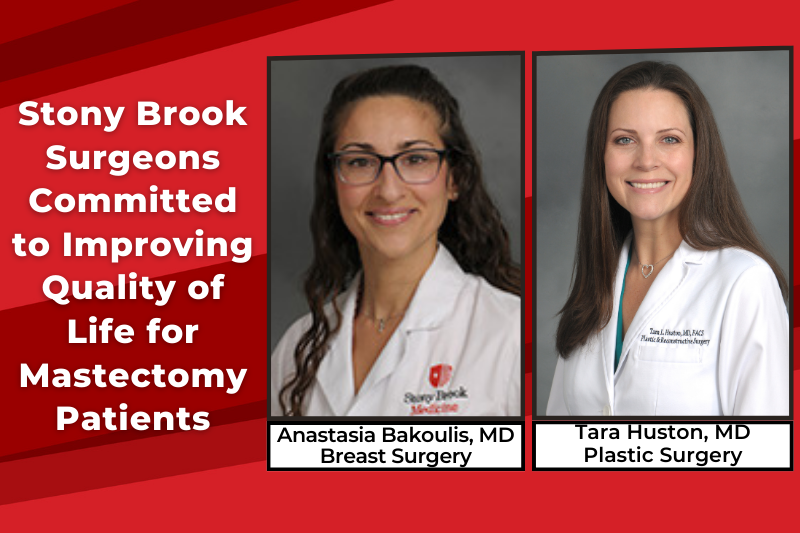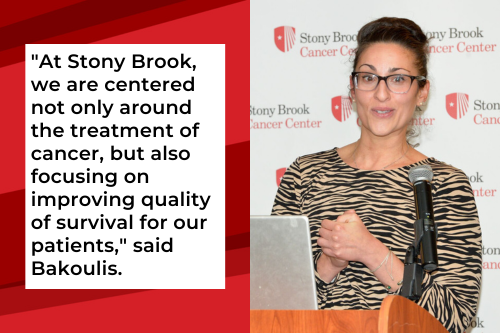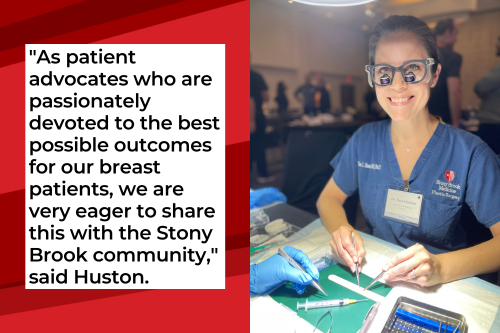
One in eight women will develop breast cancer in their lifetime. Over the past 30 years, survival rates of breast cancer patients have increased due to factors like early detection, patient education and evolving treatment methods (such as mastectomies). Stony Brook surgeons Anastasia Bakoulis, DO, and Tara Huston, MD, are committed to improving the quality of life for post-mastectomy breast cancer surgery survivors.
LOSS OF SENSATION
The popularity of reconstruction for mastectomy patients has increased as breast cancer survival rates have increased, with more than 100,000 reconstructions done annually. Doctors Bakoulis and Huston surmise there is one aspect of the post-mastectomy, post-reconstruction process that has not been given enough attention to provide the best outcomes for these patients. Up to 80 percent of women who have a mastectomy experience pain or numbness in their chest wall. Half of those women may regain sensation in their chest wall and/or reconstructed breasts within two years, but 10 percent of those experience that sensation as moderate to severe pain. Bakoulis and Huston believe neurotization is the answer to retaining and/or restoring sensation for these patients.
"At Stony Brook, we are centered not only around the treatment of cancer, but also focusing on improving quality of survival for our patients," said Bakoulis. "There is so much to celebrate after being declared 'free of disease.' We feel that [the neurotization] procedure will add to this."
 During a mastectomy procedure, the nerves to the mastectomy skin and nipple areolar complex are frequently removed. While mastectomy skin and nipple areolar complex sensory recovery can be spontaneous, it is unpredictable and most definitely diminished. Until recently, preservation and restoration of sensation to the breast envelope (mastectomy skin and nipple areolar complex) has not been a primary focus of reconstruction. Neurotization is the process of maintaining or restoring sensation to the breast following mastectomy. Bakoulis and Huston strongly believe it is vitally important to begin implementing this process as an aspect of reconstruction.
During a mastectomy procedure, the nerves to the mastectomy skin and nipple areolar complex are frequently removed. While mastectomy skin and nipple areolar complex sensory recovery can be spontaneous, it is unpredictable and most definitely diminished. Until recently, preservation and restoration of sensation to the breast envelope (mastectomy skin and nipple areolar complex) has not been a primary focus of reconstruction. Neurotization is the process of maintaining or restoring sensation to the breast following mastectomy. Bakoulis and Huston strongly believe it is vitally important to begin implementing this process as an aspect of reconstruction.
Ideally done at the time of mastectomy, neurotization involves the breast surgeon identifying and preserving the sensory nerves that would traditionally be removed during a mastectomy. If there is no evidence of cancer near the nerve, it is safe to preserve it. Once the breast surgeon has removed the mastectomy tissue and the nerve on the chest wall has been preserved, the plastic surgeon can then directly attach the nerve to the mastectomy flap or nipple areolar complex. Additional nerve length (in the form of a nerve graft) may be needed to reach from the chest wall to the remaining skin, if a flap or an implant is involved. A nerve graft is essentially a tube that allows the remaining nerve to grow in a directed manner to reach its target and restore sensation. In autologous reconstruction, using a patient's own tissue, studies have shown that up to 90% of women will regain some degree of sensory. For neurotization with implant-based reconstruction, a relative new technique, initial reports are promising and show that at least 67% of women are getting feeling back.
Because nerves grow slowly (a maximum rate of 1 millimeter per day), the earliest a woman might feel anything could be about three months post-neurotization. The return of sensation could take up to two years and, if it returns, it should be permanent. Each woman's recovery is different and there is no established time period for what they may feel or when. It is also possible that the nerve will not grow and that sensation may not return.
QUALITY OF LIFE AND PROTECTIVE SENSATION
If sensation does return, initially, a woman may feel something like a light touch, a feeling similar to a slight electric shock, an ache or an itch. Restoration of sensation may allow women to feel the hug of a family member, the warm water as she steps into the shower (protective sensation is important to safeguard against heat and other potential dangers) or the comforts of intimacy again. Bakoulis and Huston believe that loss of sensation is a functional impairment for women who have undergone mastectomy and should be addressed as part of the reconstruction process.
The neurotization process is a safe procedure. Data shows that it does not increase 30-day complication rates or 30-day readmission rates and there is no increased risk of reoperation or increased length of hospital stay (according to the National Surgery Quality Improvement Program). The risk of failure of the procedure is that sensation does not return to the mastectomy skin or nipple areolar complex. Mastectomy patients who have undergone radiation treatment should not experience a negative impact on nerve regeneration, but it may take slightly longer for sensation to be restored.
 Oncologic considerations for the neurotization procedure include tumors appropriate for nipple sparing mastectomies (i.e., not near nipple or skin, not multiple tumors) or tumors that are not very laterally and posteriorly positioned (i.e., close to chest wall; this is where the nerve enters). The only contra-indication to neurotization is if the patient’s anatomy does not allow for it. The best outcomes will be seen in healthier patients. It should also be noted that this procedure is not offered to patients who are smokers and has shown to be less successful in diabetic patients.
Oncologic considerations for the neurotization procedure include tumors appropriate for nipple sparing mastectomies (i.e., not near nipple or skin, not multiple tumors) or tumors that are not very laterally and posteriorly positioned (i.e., close to chest wall; this is where the nerve enters). The only contra-indication to neurotization is if the patient’s anatomy does not allow for it. The best outcomes will be seen in healthier patients. It should also be noted that this procedure is not offered to patients who are smokers and has shown to be less successful in diabetic patients.
Neurotization is a one-time procedure which is usually performed at the time of the mastectomy or at a subsequent surgery should the patient’s anatomy allow. If the patient's mastectomy or mastectomy and reconstruction was done in the past, it may still be possible to perform a neurotization procedure. If less of the patient's nerve is available it may be more challenging, but with the use of a nerve graft, restoring sensation may still be possible. Neurotization is an emerging and constantly evolving area of study.
Doctors Bakoulis and Huston have been trained, as a team, to perform sensory preservation and restoration via neurotization. They plan to train doctors in both Stony Brook's Breast and Plastic Surgery divisions so that more teams can offer this option to mastectomy patients. "There are a limited number of centers performing this technique," said Huston. "As patient advocates who are passionately devoted to the best possible outcomes for our breast patients, we are very eager to share this with the Stony Brook community."

